General
Missing the Market
JHM welcomes a new guest writer, Sean Kennelly. Who — in his debut article — talks about how Disney and DreamWorks attempts to make animation for grown-ups backfired and almost destroyed their core audience. Until Pixar saved the day and may help bring back the very style of animation that Disney & DreamWorks supposedly killed

Hey, gang!
Jim Hill here. And what a pleasure it is to welcome Sean Kennelly on board at JHM. At this website, we pride ourselves on trying to bring you a different take on what’s really going on in the entertainment industry. And given that Mr. Kennelly is a hardened industry vet, I’m sure that Sean is going to bring something interesting to the table.
To give you a brief bit of background on Mr. Kennelly:
Affectionately dubbed “the Disney freak” by his family, Sean comes to us on the heels of a 7-year tour of duty at several of the major Hollywood studios (Fox, DreamWorks, Columbia Pictures) and is a regular contributor to “Creative Screenwriting” magazine.
That’s a rather impressive set of credentials, don’t you think? Alright, that’s enough jabbering on my part. Without any further ado, here’s Sean Kennelly with his take on what’s currently going on the feature animation field …
For the last few years we’ve all been hearing how traditional forms of animation are dead (2-D, stop motion) and that computer animation is now the king. The problem with all this is that it focuses all the attention on the format and forgets that it is the story that keeps people in their seats. That and being aware of the expectations of your core audience.
What’s a core audience you ask? It’s the people who come back every time to see a certain genre of film (horror, drama, action-adventure, umm…animation?). Given some core audiences age and either drop the genre and move on, or they keep coming back. The key for any studio is to figure out who that target audience is and do all in their power (and marketing budget) to get them there for the opening weekend. Beyond that they hope word of mouth from that weekend is positive and will bring in even more people outside the demographic, making the film a box office winner.
Sounds simple enough. Unless you fool yourself into thinking that you can somehow change or broaden your core audience by adding elements you believe will appeal to another audience – one you hope will bring you even more praise and money. But sometimes pride can get in the way. And serving two masters is trouble in the making.
Take the example of Walt Disney Feature Animation. Started by Walt Disney back in the 1930s with “Snow White and the Seven Dwarfs,” they created films of such quality that they became a brand name which was synonymous with quality. However after Disney’s death in 1966, the guardians of his legacy could not hold on to the magic and it faded.
Still it was the only game in town and it stayed that way for years. No other studio had a feature animation division and no one wanted to challenge the king, even if Disney was no longer alive. But Disney badly needed some innovation and change.
Ron Miller, Disney’s son-in-law and head of Disney, made some improvements with the launch of the Disney Channel and the creation of Touchstone Pictures. Yet it wasn’t until Michael Eisner and Jeffrey Katzenberg came on board in 1984 that things really began to move. Hailed as an animation renaissance by many enthusiasts, the new Disney era saw an ever increasing box office [world-wide box office in millions with parenthesis – including the U.S., Canada & the rest of the world markets]. New classics such as “The Little Mermaid” ($211), “Beauty and the Beast” ($377), “Aladdin” ($504) and “The Lion King” ($783) came out on a regular basis and there seemed to be no end in sight.
Consumer confidence was riding high with each new release and parents lined up with their kids to see every Disney animated film knowing that they were in for a good time. It was a golden age. But then something happened.
“Pocahontas” ($346) came out. While the initial weekend at the box office seemed to indicate that the film was loved by all ($29 million vs. “Lion King” $40 million), it dropped off 45% the next weekend. While this is almost standard in the movie industry these days, Disney never experienced such drops with their animated films.
For comparison, “The Little Mermaid” actually gained +39% in its second week while “The Lion King” dropped a small -16% in its second week. And while you can argue all you like about the film or the market place, the numbers don’t lie. If people like it, they come and the movie makes money. A good movie always has “legs” meaning it doesn’t drop off dramatically and continues to play or sometimes to even build an even bigger audience over time. It may not be the #1 film but it will do business.
Some fans and parents were disillusioned. It looked like Disney, smelled like Disney, but inside it was an entirely different experience. Beautiful as the visuals were it was, at its core, an adult drama with a few songs and cute animals thrown in to pacify the little ones. Only the little ones were not pacified. Mom and Dad weren’t too happy either. No wonder families were headed to the exits.
Still, Disney usually made great animated films so everyone was willing to let this one pass. I mean, you can’t expect to bat a thousand every time you release a movie. It just doesn’t happen. So while audiences were disappointed, they eagerly waited for the next film.
Then “Hunchback of Notre Dame” ($325) came out. Audiences came out in droves hoping to see what magic Disney had conjured with this classic tale…but got burned. Again. The movie contained even more adult drama with some very suggestive and lusty dances thrown in just to add fuel to the fire. The film actually managed to frighten the little ones at times, not to mention how tough it was to explain why the villain was singing “this burning desire is turning me to sin”. Mom and Dad were red in the face this time.
What happened? Jeffrey Katzenberg decided to make a bold move into a new demographic – adults. Though much of the public was not aware of it, Katzenberg’s animation philosophy came out in a 1999 interview. “Seventy years ago, Walt Disney took a certain technique called animation and told the kind of stories he wanted to tell, which were fairy tales, stories and films for children, which was a lovely idea and informed everything he did. I respect and admire that. But it’s not what I want to do. What I want to make is a Spielberg movie in animation, or a Barry Sonnenfield or a Martin Scorcese or a David Lean. The tradition up to now has been to do things cartoony. We don’t mean to be pretentious, but we set out to do fine art. I’m not saying that cartooning isn’t fine art, just a very, very different style.” [“Fine Tooning,” Caroline Westbrook, “Empire,” Issue No. 115, January `99, pp 108-111.]
Though he left Disney in 1994, just after “The Lion King” was released, his influence and philosophy was all over the releases that followed. You see with a 3-5 year production pipeline, it was years before Katzenberg’s philosophy left the building. But the damage was already done. Disney was no longer golden. They lost the touch. The core audience deserted the Disney brand at an ever increasing rate until the real low point was reached years later with “Home on the Range” ($103).
So who is the core audience for a Disney animated film? David Stainton, former Disney animation chief, nailed it in a 2003 Los Angeles Times interview where he said that the core audience for Disney animation was 4-10 year-olds and their parents. That doesn’t mean other ages or demographics don’t enjoy or appreciate the films, it just means that the boatload of the box office cash will come from this group. Deny it at your own risk. Disney did and DreamWorks joined them in playing to the wrong crowd.
When Jeffery Katzenberg left Disney to form DreamWorks SKG in 1994 he brought with him his adult animation philosophy, creating films such as “Prince of Egypt” ($218), “Road to El Dorado” ($76 million) and “Spirit: Stallion of the Cimarron” ($122). Gone were the cutesy characters of animation days gone by, replaced by more adult themes and stories (“Prince of Egypt” & “Road to El Dorado”) as well as experiments in realism (“Spirit”) where the animals never really spoke or sang. Beautiful animation? Yes. But it produced a pitiful box office (with the exception of “Prince of Egypt” which had a core religious audience that helped drive the numbers up). Remember these are world-wide numbers, not just U.S. & Canadian box office (known as domestic box office).
What went wrong? David Stainton again summed it up nicely. “If you think you’re making a movie for everybody, you’re making a movie for nobody.” And that’s what happened. By ignoring the core audience (4-10 year-olds and their parents), they actually undermined their own business. Nobody came to see the films. So where did the audience go? They fled to the only company making animated films for children and their parents, Pixar Animation.
Before he left Disney, Katzenberg made a 3-picture deal for Pixar Animation. The deal saved financially troubled Pixar, which was surviving by producing computer animated commercials for outside companies. The result was “Toy Story” ($361) which came out in November 1995, the very same year as “Pocahontas”. Yet it was still #13 at the domestic box office when “Hunchback of Notre Dame” opened…in JUNE of 1996. This was a film with legs. Eerily similar to Disney’s rise in the 80s and 90s, Pixar built an ever increasing audience with each new release. “A Bug’s Life” ($363), “Toy Story 2” ($485), “Monsters, Inc.” ($525), “Finding Nemo” ($864), and “The Incredibles” ($631). And while “The Incredibles” did less business than “Finding Nemo,” keep in mind that it did better box office than every Disney animated movie ever released with the exception of “The Lion King” and “Cars” looks to be another kid-friendly picture.
DreamWorks caught on and had monster hits with “Shrek” ($484), “Shrek 2” ($920), “Shark Tale” ($363) and “Madagascar” ($527). While there still seems to be a more “adult” influence in these films, they manage to be kid-oriented enough to bring in the core audience and a whole lot more.
Even other studios such as 20th Century Fox figured it out. After making an animated teen action-adventure bomb called “Titan A.E.” (hint: teens are the LAST demographic to see an animated film) that brought in $36 million world-wide, they bought Blue Sky Studios and made “Ice Age” ($382) which has already spawned a sequel. Obviously they learned their lesson too.
But did computer animation save the day? I don’t think so. It was lucky timing. Pixar came on the scene and picked up the core animation audience just as Disney took aim at a different demographic. And like any brand-loyal consumer, the public figured if it was computer animated, it must be good. Studios caught on and thus we have a whole new herd of computer animated films coming out. Will they all be winners? If they have good stories and play to the core audience, they might. And 2-D or “traditional” animation has just as much a chance at succeeding as any other style of animation out there, but it may take time to rebuild the brand. Disney and DreamWorks collectively killed it yet they may be the very ones who could save it. In fact it was no surprise to me to hear about “Enchanted” and the possibility of a traditional animation revival. The fact that Pixar’s leadership is spearheading this effort just shows that they understand that the style of animation has nothing to do with the success of the picture as long as you remember the moral of this story.
What is the moral of this story, you ask? Play to your core audience. Whether it’s a demographic or fans of a particular genre, know your audience and give them what they expect. Even DreamWorks finally realized this after “Sinbad” ($73 million) performed so poorly. I honestly loved the film, but it was nothing more than an animated action-adventure film which was NOT geared to 4-10 year olds. I worked at DreamWorks when it was released and I saw it coming. I knew there was no hope for it because it played to the wrong crowd. That summer as DreamWorks solicited story pitches from the employees (something they do annually), the written notice specifically stated that this year they would not be taking any action-adventure stories. Lesson learned. To infinity and hopefully beyond!
General
Seward Johnson bronzes add a surreal, artistic touch to NYC’s Garment District

Greetings from NYC. Nancy and I drove down from New
Hampshire yesterday because we'll be checking out
Disney Consumer Products' annual Holiday Showcase later today.
Anyway … After checking into our hotel (i.e., The Paul.
Which is located down in NYC's NoMad district), we decided to grab some dinner.
Which is how we wound up at the Melt Shop.
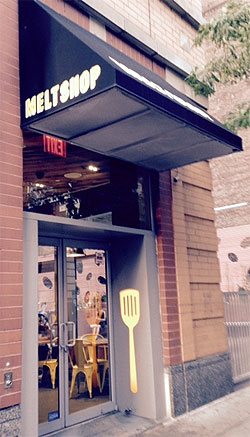
Photo by Jim Hill
Which is this restaurant that only sells grilled cheese sandwiches.
This comfort food was delicious, but kind of on the heavy side.

Photo by Jim Hill
Which is why — given that it was a beautiful summer night
— we'd then try and walk off our meals. We started our stroll down by the Empire
State Building
…
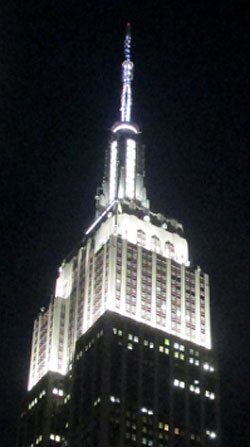
Photo by Jim Hill
… and eventually wound up just below Times
Square (right behind where the Waterford Crystal Times Square New
Year's Eve Ball is kept).

Photo by Jim Hill
But you know what we discovered en route? Right in the heart
of Manhattan's Garment District
along Broadway between 36th and 41st? This incredibly cool series of life-like
and life-sized sculptures that Seward
Johnson has created.

Photo by Jim Hill
And — yes — that is Abraham Lincoln (who seems to have
slipped out of WDW's Hall of Presidents when no one was looking and is now
leading tourists around Times Square). These 18 painted
bronze pieces (which were just installed late this past Sunday night / early
Monday morning) range from the surreal to the all-too-real.

Photo by Jim Hill
Some of these pieces look like typical New Yorkers. Like the
business woman planning out her day …

Photo by Jim Hill
… the postman delivering the mail …

Photo by Jim Hill
… the hot dog vendor working at his cart …

Photo by Jim Hill
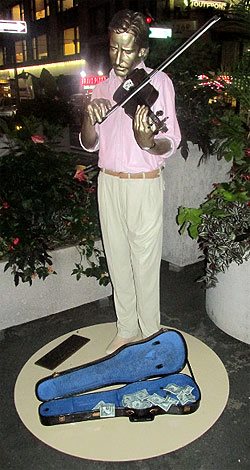
Photo by Jim Hill
… the street musician playing for tourists …

Photo by Jim Hill
Not to mention the tourists themselves.
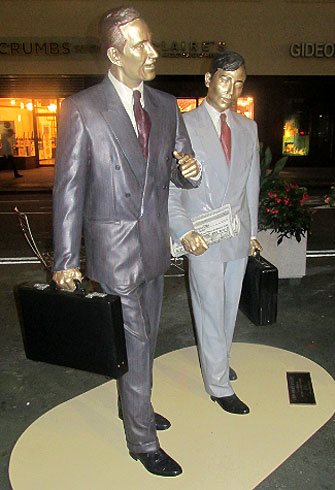
Photo by Jim Hill
But right alongside the bronze businessmen …

Photo by Jim Hill
… and the tired grandmother hauling her groceries home …
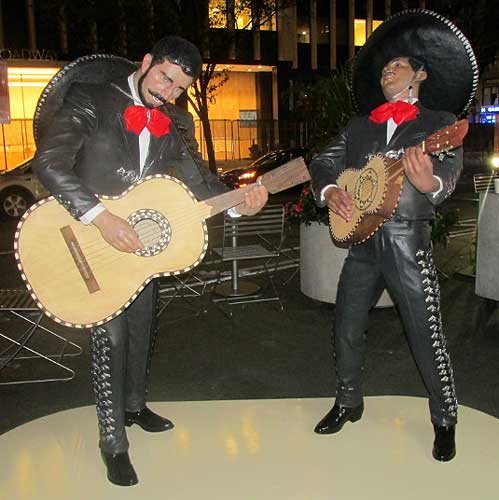
Photo by Jim Hill
… there were also statues representing people who were
from out-of-town …

Photo by Jim Hill
… or — for that matter — out-of-time.

Photo by Jim Hill
These were the Seward Johnson pieces that genuinely beguiled. Famous impressionist paintings brought to life in three dimensions.

Note the out-of-period water bottle that some tourist left
behind. Photo by Jim Hill
Some of them so lifelike that you actually had to pause for
a moment (especially as day gave way to night in the city) and say to yourself
"Is that one of the bronzes? Or just someone pretending to be one of these
bronzes?"
Mind you, for those of you who aren't big fans of the
impressionists …

Photo by Jim Hill
… there's also an array of American icons. Among them
Marilyn Monroe …
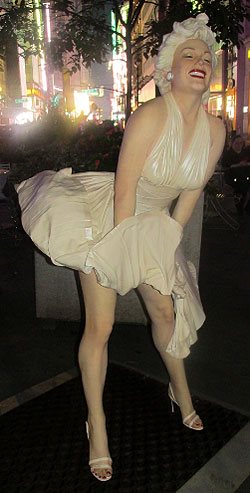
Photo by Jim Hill
… and that farmer couple from Grant Wood's "American
Gothic."

Photo by Jim Hill
But for those of you who know your NYC history, it's hard to
beat that piece which recreates Alfred Eisenstaedt's famous photograph of V-J Day in Times Square.

Photo by Jim Hill
By the way, a 25-foot-tall version of this particular Seward
Johnson piece ( which — FYI — is entitled "Embracing Peace") will actually
be placed in Times Square for a few days on or around August 14th to commemorate the 70th
anniversary of Victory Over Japan Day (V-J Day).

Photo by Jim Hill
By the way, if you'd like to check these Seward Johnson bronzes in
person (which — it should be noted — are part of the part of the Garment
District Alliance's new public art offering) — you'd best schedule a trip to
the City sometime over the next three months. For these pieces will only be on
display now through September 15th.
General
Wondering what you should “Boldly Go” see at the movies next year? The 2015 Licensing Expo offers you some clues

Greeting from the 2015 Licensing Expo, which is being held
at the Mandalay Bay
Convention Center in Las
Vegas.

Photo by Jim Hill
I have to admit that I enjoy covering the Licensing Expo.
Mostly becomes it allows bloggers & entertainment writers like myself to
get a peek over the horizon. Scope out some of the major motion pictures &
TV shows that today's vertically integrated entertainment conglomerates
(Remember when these companies used to be called movie studios?) will be
sending our way over the next two years or so.
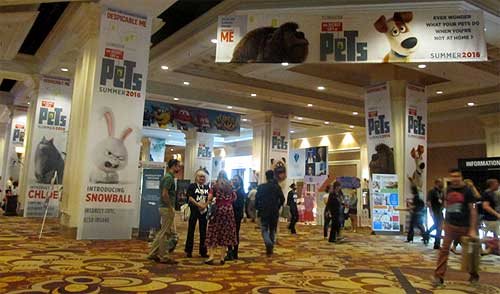
Photo by Jim Hill
Take — for example — all of "The Secret Life of
Pets" banners that greeted Expo attendees as they made their way to the
show floor today. I actually got to see some footage from this new Illumination
Entertainment production (which will hit theaters on July 8, 2016) the last time I was in Vegas. Which
was for CinemaCon back in April. And the five or so minutes of film that I viewed
suggested that "The Secret Life of Pets" will be a really funny
animated feature.

Photo by Jim Hill
Mind you, Universal Pictures wanted to make sure that Expo
attendees remembered that there was another Illumination Entertainment production
coming-to-a-theater-near-them before "The Secret Life of Pets" (And
that's "Minions," the "Despicable Me" prequel. Which
premieres at the Annecy International Animated Film Festival next week but
won't be screened stateside 'til July 10th of this year). Which is why they had
three minions who were made entirely out of LEGOS loitering out in the lobby.

Photo by Jim Hill
And Warner Bros. — because they wanted "Batman v
Superman: Dawn of Justice" to start trending on Twitter today — brought
the Batmobile to Las Vegas.
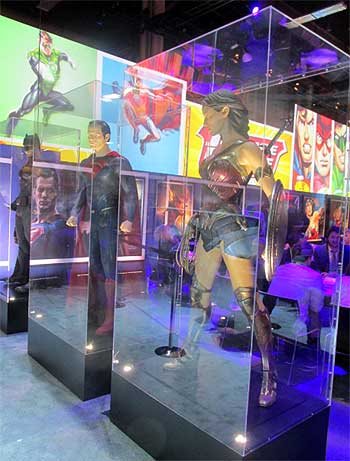
Photo by Jim Hill
Not to mention full-sized macquettes of Batman, Superman and
Wonder Woman. Just so conventioneers could then see what these DC superheroes
would actually look like in this eagerly anticipated, March 25, 2016 release.

Photo by Jim Hill
That's the thing that can sometimes be a wee bit frustrating
about the Licensing Expo. It's all about delayed gratification. You'll come
around a corner and see this 100 foot-long ad for "The Peanuts Movie"
and think "Hey, that looks great. I want to see that Blue Sky Studios production
right now." It's only then that you notice the fine print and realize that
"The Peanuts Movie" doesn't actually open in theaters 'til November
6th of this year.

Photo by Jim Hill
And fan of Blue Sky's "Ice Age" film franchise are in for an even
longer wait. Given that the latest installment in that top grossing series
doesn't arrive in theaters 'til July
15, 2016.

Photo by Jim Hill
Of course, if you're one of those people who needs immediate
gratification when it comes to your entertainment, there was stuff like that to
be found at this year's Licensing Expo. Take — for example — how the WWE
booth was actually shaped like a wrestling ring. Which — I'm guessing — meant
that if the executives of World Wrestling Entertainment, Inc. didn't like
the offer that you were making, they were then allowed to toss you out over the
top rope, Royal Rumble-style.

Photo by Jim Hill
I also have to admit that — as a longtime Star Trek fan —
it was cool to see the enormous Starship Enterprise that hung in place over the
CBS booth. Not to mention getting a glimpse of the official Star Trek 50th
Anniversary logo.
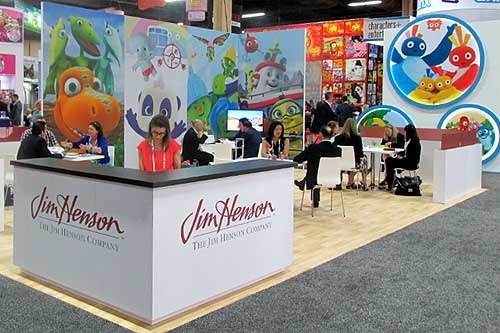
Photo by Jim Hill
I was also pleased to see lots of activity in The Jim Henson
Company booth. Which suggests that JHC has actually finally carved out a
post-Muppets identity for itself.

Photo by Jim Hill
Likewise for all of us who were getting a little concerned
about DreamWorks Animation (what with all the layoffs & write-downs &
projects that were put into turnaround or outright cancelled last year), it was
nice to see that booth bustling.

Photo by Jim Hill
Every so often, you'd come across some people who were
promoting a movie that you weren't entirely sure that you actually wanted to
see (EX: "Angry Birds," which Sony Pictures Entertainment / Columbia
Pictures will be releasing to theaters on May 20, 2016). But then you remembered that Clay Kaytis —
who's this hugely talented former Walt Disney Animation Studios animator — is
riding herd on "Angry Birds" with Fergal Reilly. And you'd think
"Well, if Clay's working on 'Angry Birds,' I'm sure this animated feature
will turn out fine."

Photo by Jim Hill
Mind you, there were reminders at this year's Licensing Expo
of great animated features that we're never going to get to see now. I still
can't believe — especially after that brilliant proof-of-concept footage
popped up online last year — that Sony execs decided not to go forward
with production of Genndy Tartakovsky's
"Popeye" movie. But that's the
cruel thing about the entertainment business, folks. It will sometime break
your heart.
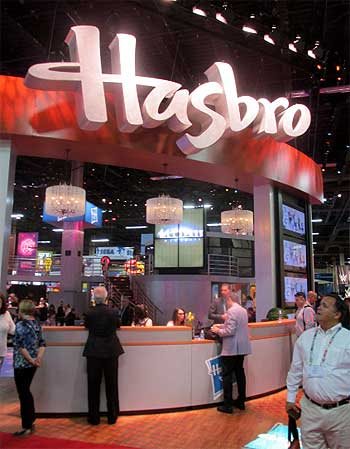
Photo by Jim Hill
And make no mistake about this. The Licensing Expo is all
about business. That point was clearly driven home at this year's show when —
as you walked through the doors of the Mandalay
Bay Convention Center
— the first thing that you saw was the Hasbros Booth. Which was this gleaming,
sleek two story-tall affair full of people who were negotiating deals &
signing contracts for all of the would-be summer blockbusters that have already
announced release dates for 2019 & beyond.

Photo by Jim Hill
"But what about The Walt Disney Company?," you
ask. "Weren't they represented on the show floor at this year's Licensing
Expo?" Not really, not. I mean, sure. There were a few companies there hyping
Disney-related products. Take — for example — the Disney Wikkeez people.
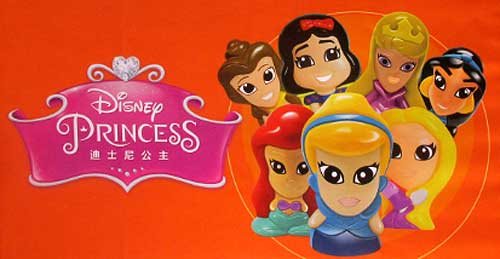
Photo by Jim Hill
I'm assuming that some Disney Consumer Products exec is
hoping that Wikkeez will eventually become the new Tsum Tsum. But to be blunt,
these little hard plastic figures don't seem to have the same huggable charm
that those stackable plush do. But I've been wrong before. So let's see what
happens with Disney Wikkeez once they start showing up on the shelves of the
Company's North American retail partners.

Photo by Jim Hill
And speaking of Disney's retail partners … They were
meeting with Mouse House executives behind closed doors one floor down from the
official show floor for this year's Licensing Expo.

Photo by Jim Hill
And the theme for this year's invitation-only Disney shindig? "Timeless
Stories" involving the Disney, Pixar, Marvel & Lucasfilm brands that
would then appeal to "tomorrow's consumer."

Photo by Jim Hill
And just to sort of hammer home the idea that Disney is no
longer the Company which cornered the market when it comes to little girls
(i.e., its Disney Princess and Disney Fairies franchises), check out this
wall-sized Star Wars-related image that DCP put up just outside of one of its
many private meeting rooms. "See?," this carefully crafted photo
screams. "It isn't just little boys who want to wield the Force. Little
girls also want to grow up and be Lords of the Sith."
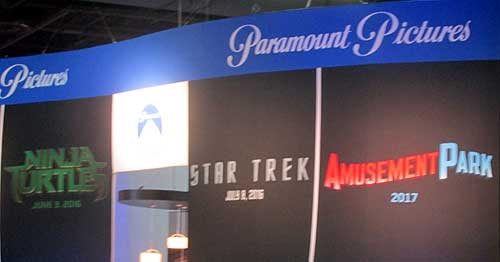
Photo by Jim Hill
One final, kind-of-ironic note: According to this banner,
Paramount Pictures will be releasing a movie called "Amusement Park"
to theaters sometime in 2017.

Photo by Jim Hill
Well, given all the "Blackfish" -related issues
that have been dogged SeaWorld Parks & Entertainment over the past two years, I'm
just hoping that they'll still be in the amusement park business come 2017.
Your thoughts?
General
It takes more than three circles to craft a Classic version of Mickey Mouse
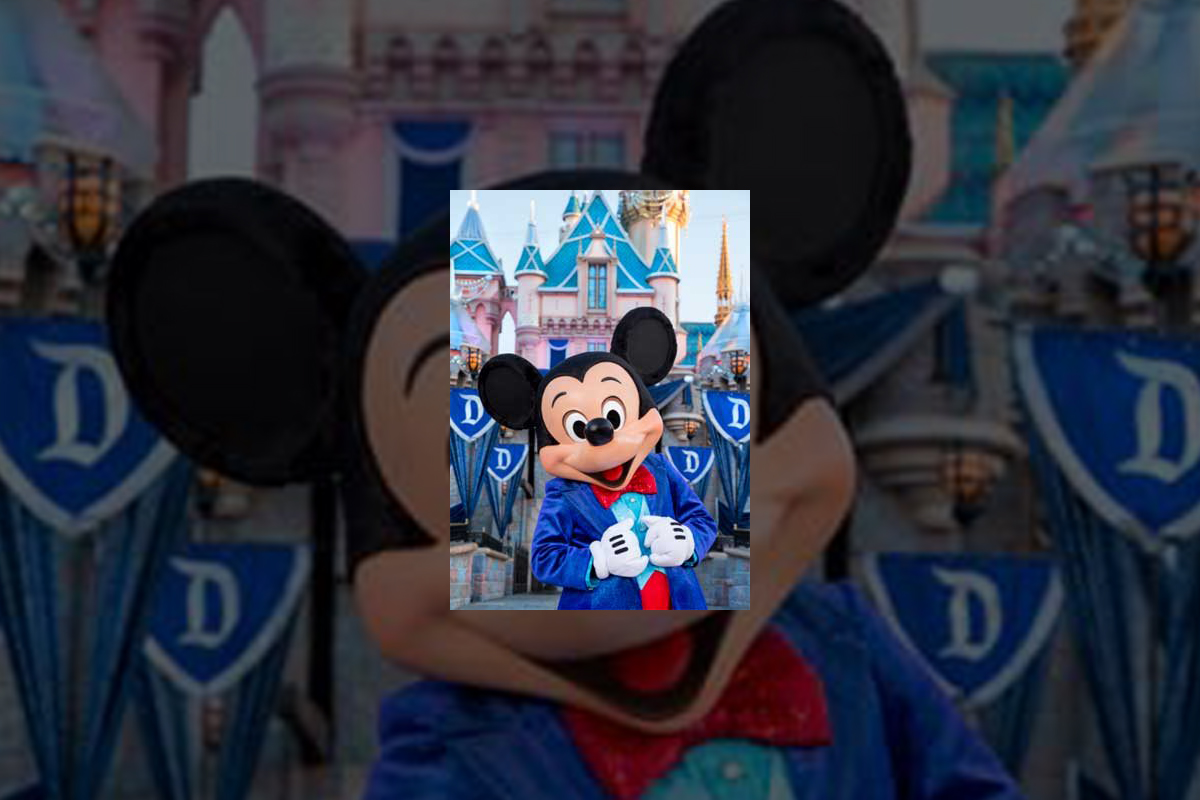
You know what Mickey Mouse looks like, right? Little guy,
big ears?
Truth be told, Disney's corporate symbol has a lot of
different looks. If Mickey's interacting with Guests at Disneyland
Park (especially this summer, when
the Happiest Place on Earth
is celebrating its 60th anniversary), he looks & dresses like this.
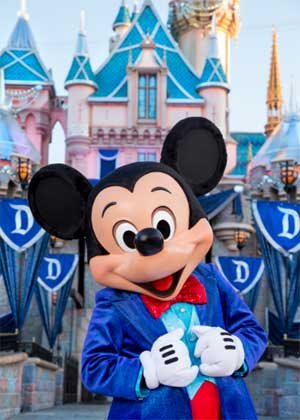
Copyright Disney Enterprises,
Inc.
All rights reserved
Or when he's appearing in one of those Emmy Award-winning shorts that Disney
Television Animation has produced (EX: "Bronco Busted," which debuts
on the Disney Channel tonight at 8 p.m. ET / PT), Mickey is drawn in a such a
way that he looks hip, cool, edgy & retro all at the same time.
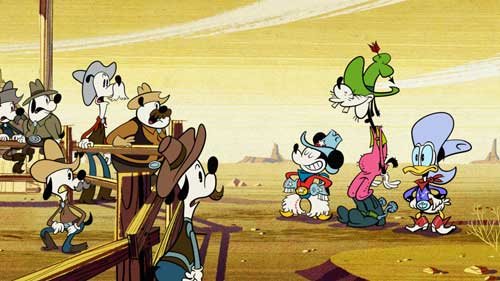
Copyright Disney Enterprises, Inc. All rights
reserved
Looking ahead to 2017 now, when Disney Junior rolls out "Mickey and the
Roadster Racers," this brand-new animated series will feature a sportier version
of Disney's corporate symbol. One that Mouse House managers hope will persuade
preschool boys to more fully embrace this now 86 year-old character.

Copyright Disney Enterprises,
Inc. All rights reserved
That's what most people don't realize about the Mouse. The
Walt Disney Company deliberately tailors Mickey's look, even his style of
movement, depending on what sort of project / production he's appearing in.
Take — for example — Disney
California Adventure
Park's "World of Color:
Celebrate!" Because Disney's main mouse would be co-hosting this new
nighttime lagoon show with ace emcee Neil Patrick Harris, Eric Goldberg really had
to step up Mickey's game. Which is why this master Disney animator created
several minutes of all-new Mouse animation which then showed that Mickey was
just as skilled a showman as Neil was.

Copyright Disney Enterprises,
Inc.
All rights reserved
Better yet, let's take a look at what the folks at Avalanche Studios just went
through as they attempted to create a Classic version of Mickey & Minnie.
One that would then allow this popular pair to become part of Disney Infinity
3.0.
"I won't lie to you. We were under a lot of pressure to
get the look of this particular version of Mickey — he's called Red Pants
Mickey around here — just right," said Jeff Bunker, the VP of Art
Development at Avalanche Studios, during a recent phone interview. "When
we brought Sorcerer Mickey into Disney Infinity 1.0 back in January of 2014,
that one was relatively easy because … Well, everyone knows what Mickey Mouse
looked like when he appeared in 'Fantasia.' "

Copyright Disney Enterprises,
Inc. All rights reserved
"But this time around, we were being asked to design
THE Mickey & Minnie," Bunker continued. "And given that these Classic
Disney characters have been around in various different forms for the better
part of the last century … Well, which look was the right look?"
Which is why Jeff and his team at Avalanche Studios began watching hours &
hours of Mickey Mouse shorts. As they tried to get a handle on which look would
work best for these characters in Disney Infinity 3.0.

Copyright Disney
Enterprises, Inc. All rights reserved
"And we went all the way back to the very start of Mickey's career. We began
with 'Steamboat Willie' and then watched all of those black & white Mickey shorts
that Walt made back in the late 1920s & early 1930s. From there, we
transitioned to his Technicolor shorts. Which is when Mickey went from being
this pie-eyed, really feisty character to more of a well-behaved leading
man," Bunker recalled. "We then finished out our Mouse marathon by
watching all of those new Mickey shorts that Paul Rudish & his team have
been creating for Disney Television Animation. Those cartoons really recapture
a lot of the spirit and wild slapstick fun that Mickey's early, black &
white shorts had."
But given that the specific assignment that Avalanche Studios had been handed
was to create the most appealing looking, likeable version of Mickey Mouse
possible … In the end, Jeff and his team wound up borrowing bits & pieces
from a lot of different versions of the world's most famous mouse. So that
Classic Mickey would then look & move in a way that best fit the sort of
gameplay which people would soon be able to experience with Disney Infinity
3.0.

Copyright Disney Enterprises,
Inc. All rights reserved
"That — in a lot of ways — was actually the toughest
part of the Classic Mickey design project. You have to remember that one of the
key creative conceits of Disney Infinity
is that all the characters which appear in this game are toys," Bunker
stated. "Okay. So they're beautifully detailed, highly stylized toy
versions of beloved Disney, Pixar, Marvel & Lucasfilm characters. But
they're still supposed to be toys. So our Classic versions of Mickey &
Minnie have the same sort of thickness & sturdiness to them that toys have.
So that they'll then be able to fit right in with all of the rest of the
characters that Avalanche Studios had previously designed for Disney Infinity."
And then there was the matter of coming up with just the
right pose for Classic Mickey & Minnie. Which — to hear Jeff tell the
story — involved input from a lot of Disney upper management.
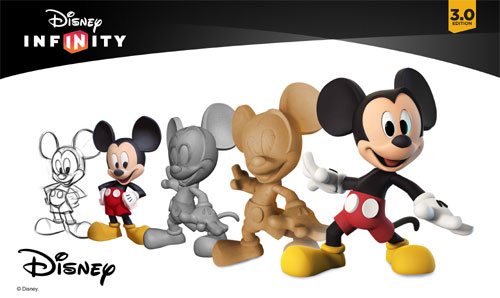
Copyright Disney Enterprises,
Inc. All rights reserved
"Everyone within the Company seemed to have an opinion
about how Mickey & Minnie should be posed. More to the point, if you Google
Mickey, you then discover that there are literally thousands of poses out there
for these two. Though — truth be told — a lot of those kind of play off the
way Mickey poses when he's being Disney's corporate symbol," Bunker said.
"But what I was most concerned about was that Mickey's pose had to work
with Minnie's pose. Because we were bringing the Classic versions of these
characters up into Disney Infinity 3.0 at the exact same time. And we wanted to
make sure — especially for those fans who like to put their Disney Infinity
figures on display — that Mickey's pose would then complement Minnie.
Which is why Jeff & the crew at Avalanche Studios
decided — when it came to Classic Mickey & Minnie's pose — that they
should go all the way back to the beginning. Which is why these two Disney icons
are sculpted in such a way that it almost seems as though you're witnessing the
very first time Mickey set eyes on Minnie.

Copyright Disney Enterprises,
Inc. All rights reserved
"And what was really great about that was — as soon as
we began showing people within the Company this pose — everyone at Disney
quickly got on board with the idea. I mean, the Classic Mickey that we sculpted
for Disney Infinity 3.0 is clearly a very playful, spunky character. But at the
same time, he's obviously got eyes for Minnie," Bunker concluded. "So
in the end, we were able to come up with Classic versions of these characters
that will work well within the creative confines of Disney Infinity 3.0 but at
the same time please those Disney fans who just collect these figures because
they like the way the Disney Infinity characters look."
So now that this particular design project is over, does
Jeff regret that Mouse House upper management was so hands-on when it came to
making sure that the Classic versions of Mickey & Minnie were specifically
tailored to fit the look & style of gameplay found in Disney Infinity 3.0?

Copyright Lucasfilm / Disney
Enterprises, Inc. All rights reserved
"To be blunt, we go through this every time we add a new character to the
game. The folks at Lucasfilm were just as hands-on when we were designing the
versions of Darth Vader and Yoda that will also soon be appearing in Disney
Infinity 3.0," Bunker laughed. "So in the end, if the character's
creators AND the fans are happy, then I'm happy."
This article was originally posted on the Huffington Post's Entertainment page on Tuesday, June 9, 2015
-

 Film & Movies7 months ago
Film & Movies7 months agoBefore He Was 626: The Surprisingly Dark Origins of Disney’s Stitch
-

 History5 months ago
History5 months agoCalifornia Misadventure
-

 History10 months ago
History10 months agoThe Super Bowl & Disney: The Untold Story Behind ‘I’m Going to Disneyland!’
-

 Television & Shows11 months ago
Television & Shows11 months agoHow the Creators of South Park Tricked A-List Celebrities to Roast Universal – “Your Studio & You”
-

 Film & Movies6 months ago
Film & Movies6 months agoThe Best Disney Animation Film Never Made – “Chanticleer”
-

 Theme Parks & Themed Entertainment5 months ago
Theme Parks & Themed Entertainment5 months agoThe ExtraTERRORestrial Files
-

 History6 months ago
History6 months agoWhy Disney’s Animal Kingdom’s Beastly Kingdom Was Never Built
-

 Television & Shows8 months ago
Television & Shows8 months agoThe Untold Story of Super Soap Weekend at Disney-MGM Studios: How Daytime TV Took Over the Parks






